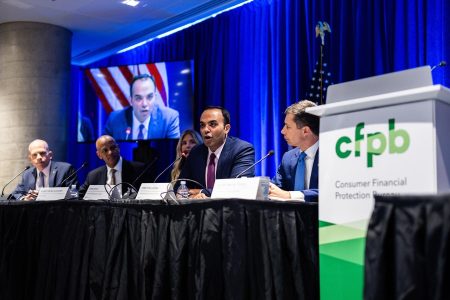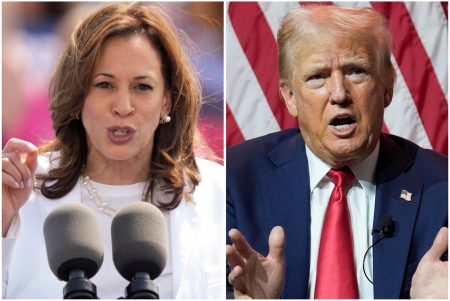Key takeaways
- The Federal Reserve is likely to cut interest rates at least once in 2024, with the largest share of officials expecting three cuts.
- The timing and frequency of rate cuts will depend on a variety of factors, including inflation and the labor market.
- Consumers should not expect near-zero interest rates anytime soon, as the Fed expects to only modestly cut borrowing costs in the year ahead.
When it comes to the Federal Reserve cutting interest rates, it’s not a question of “if.” It’s a matter of “when.”
Despite a string of data showing hotter-than-expected inflation, officials on the Federal Reserve still think it’ll be appropriate this year to eventually start walking back a few of the massive rate increases that they’ve approved since 2022 to squelch inflation. One of the biggest surprises from the Fed’s latest rate-setting meeting in March: The median estimate among Fed officials still calls for three rate cuts for 2024, matching the calls from December that initially shocked investors and economists alike. Nine officials see three cuts, five officials now see two cuts and two officials see just one. Meanwhile, only two policymakers see rates holding steady.
What has been taken off the table, however, are the aggressive rate cuts investors had been crossing their fingers for. Three months ago, one official expected six cuts and four officials predicted four cuts, reflecting that some voices on the FOMC saw a reason to go faster at the time. No more. Only one official now continues to see four rate cuts, and no official is currently expecting six rate cuts in 2024.
The faces behind the projections are beginning to come forward. Voting FOMC member and Atlanta Fed President Raphael Bostic said in public remarks since the Fed’s March meeting that he now only expects one quarter-point rate cut this year, beginning “sometime in the summertime.” Chicago Fed President Austan Goolsbee, another voter, continues to project three rate cuts, but Fed Governor Christopher Waller says he’s looking for a “couple months” of better inflation data and isn’t in a rush.
Estimates aside, the Fed’s projections are for the end of the year, offering no specific clues on timing. Investors still have their own baseline estimate: The majority think the Fed will cut interest rates three times total, beginning in June and continuing at every other meeting, CME Group’s FedWatch tool shows. The nation’s economists, meanwhile, are split on whether the Fed will cut borrowing costs at its June meeting or wait a bit longer — reducing rates in either July or September.
One point’s for certain: No matter when the Fed cuts rates or how much, it’ll do little to help heal the pain of higher interest rate for consumers. If those projections come to fruition, the Fed’s benchmark will fall to 4.5-4.75 percent, returning back to levels last seen in January 2023. Before that, however, the Fed hadn’t lifted rates that high since 2007. Yields on the savings accounts and certificates of deposit (CDs) at the nation’s top banks are the highest in over a decade, but so are mortgage rates, auto loans and more.
Interest rates took the elevator going up but will take the stairs coming down.
— Greg McBride, Bankrate Chief Financial Analyst
The Fed looks more likely to cut borrowing costs than increase them next year
Fed Chair Jerome Powell indicated during the Fed’s March post-meeting press conference that Fed officials weren’t panicking about the latest inflation data. In fact, policymakers always expected that inflation’s journey back toward their 2 percent goalpost might be full of zigs and zags.
“We’re not going to overreact to these two months of data, but we’re not going to ignore them,” Powell said. ”They haven’t really changed the overall story, which is that of inflation moving down gradually on a sometimes-bumpy road toward 2 percent.”
Powell also pointed out that interest rates are likely restrictive enough to bring inflation back down, implying that U.S. central bankers think their next move is most likely a cut. But that doesn’t mean the bar for one is low. Powell said officials mainly want confidence that inflation is heading in the right direction — and confidence can only be established with time.
Part of the reason why economists say the Fed is unlikely to cut interest rates earlier than June — for now — is because of the breadth of data Powell & Co. could have by only then. By the time the Fed meets in June, officials will have three inflation reports from the Bureau of Labor Statistics, as well as the Department of Commerce, the Fed’s preferred gauge. Officials will also have three updates on the job market.
A lot could be at stake. Cutting rates too soon could give the economy more juice, potentially exacerbating inflation and requiring an even longer fight. Leaving rates too high, however, could risk slowing the economy needlessly, weighing on the job market and kickstarting the long-feared recession.
The Fed might not be ready to cut interest rates if progress with inflation is stalling. If the inflation trends of the past six months continued for a full year, prices would rise at a 3.2 percent annual rate — matching the current 3.2 percent rate from February and reflecting no progress. Excluding food and energy, the past six months of inflation would put so-called “core” prices on pace for a 4.12 percent annual rate, higher than it’s current 3.8 percent level. A resurgence in airline and new vehicle prices, as well as stubborn inflation surrounding insurance and shelter costs, are currently causing inflation to be sticky.
“The downside of cutting rates is salient and the upside of cutting rates is not as clear,” says Ricardo De la O, assistant professor of financial and business economics at the University of Southern California Marshall School of Business. “I don’t think they want to take the risk of having another narrative that they cut too soon again. Even when they cut rates, they’re going to be moderate about it.”
But the Fed has a dual mandate: maximum employment and stable prices. The job market remains resilient, with joblessness holding at historically low levels for the longest period of time since the 1960s. Yet, unemployment is creeping up, most recently hitting a two-year high in February. Employers have created about 231,000 jobs each month, on average, for the past six months, but matching businesses’ desires to hire is a growing labor force — a supply-side boom that is expected to wane throughout 2024. Once the pool of available workers shrinks, job growth could begin to slow, too.
A weaker job market could also prompt the Fed to cut rates sooner, Powell said in March. In part, that’s because higher unemployment could do some of the Fed’s work for it. Weaker purchasing power and limited paychecks take away the very steam that leads to elevated inflation.
“If there were a significant weakening in the data, particularly in the labor market, that could also be a reason for us to begin the process of reducing rates again,” Powell said.
Previous rate cuts in 1994 could offer clues on how Fed officials plan to move forward
For Fed watchers looking for clues on the timing for rate cuts, history can be a guide. The Fed ultimately hopes to “softly land” the U.S. economy, reducing inflation without harming the job market. The environment paves the way for the Fed to gently lower interest rates as the U.S. economy gradually normalizes. To do it right, officials need to cut interest rates long before inflation officially reaches 2 percent.
The odds, however, have never been in the Fed’s favor. Just once before — in 1994 — did Fed officials manage to raise rates, then gradually cut them as inflation cooled, without spurring a recession.
“And that’s a period of 60 years over 11 business cycles,” says Lindsey Piegza, chief economist at Stifel Financial.
Back then, officials raised borrowing costs eight times by a total of 2.25 percentage points between February 1994 and February 1995, doubling the federal funds rate, a Bankrate analysis of historic Fed moves shows. Then, by July 1995, officials began cutting interest rates, reducing them three times by January 1996, a six-meeting period.
It’s in the very nature of a soft landing that the Fed doesn’t need to rush to cut, Piegza says.
“A reasonable expectation would be every other meeting,” she says. “That gives them enough time to continue to assess the data. Every meeting would just be too aggressive.”
Yet, interest rates in 1994 were higher than the Fed’s March 2022 starting point of near-zero, rising from 3 percent to 6 percent. And another key factor separates now and then: Inflation peaked at 3.1 percent, three times slower than its post-pandemic peak.
What Fed officials are saying about rate cuts
I don’t think we really know whether this is a bump on the road or something more. We’ll have to find out. In the meantime, the economy is strong, the labor market is strong, inflation has come way down, and that gives us the ability to approach this question carefully.
— Jerome Powell, Federal Reserve Chairman
In my view, it is appropriate to reduce the overall number of rate cuts or push them further into the future in response to the recent data.
— Christopher Waller, Fed Governor
Everything is always on the table or off the table. We’re in an uncertain state, but it doesn’t feel to me like we’ve changed fundamentally the story that we’re getting back to target. I was at the median for this one.
— Austan Goolsbee, Chicago Fed President
What rate cuts in 2024 could mean for your money
While the timing for rate cuts may still be a guessing game, the message for consumers is clear: Barring a major economic catastrophe, near-zero interest rates from the Fed aren’t around the corner anytime soon.
“It would take a severe recession to cause the Fed to not just pause and not just cut rates moderately, but to decide it’s going to go aggressive in the other direction,” says Yung-Yu Ma, chief investment officer for BMO Wealth Management. “A soft-landing where the Fed is aggressively cutting rates is not a scenario we think is likely to play out.”
The Fed’s decisions influence the rates consumers pay to finance purchases both big and small, from credit cards or personal loans to car loans and even mortgages. As the Fed ponders the timing for rate cuts, it’s important for consumers to focus on:
- Paying down debt: Those with high-cost, variable-rate debt are hit hardest in a high-rate era.
- Rethinking big-ticket purchases: Cars break down or roofs leak regardless of what happens with rates, so you can’t always time the market. But if you can afford to wait on financing a major spending decision, you might end up saving. McBride expects interest rates on every consumer loan to fall in 2024.
- Prioritizing your savings: Elevated interest rates mean banks will still offer competitive yields on deposit accounts, helping you grow your savings faster.
- Locking in your gains for the long haul: Yields on savings accounts are variable, so rates hitting their peak may mean it’s a good time to consider locking in a CD.
“It’s been all about inflation, inflation, inflation at the Fed,” Ma adds. “The trend for inflation — if it continues to stay on a downward trajectory — will give the Fed a little bit of breathing room to take some of those considerations about how the economy is evolving more into play.”
Read the full article here










